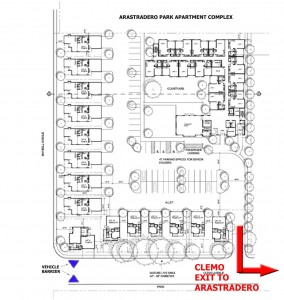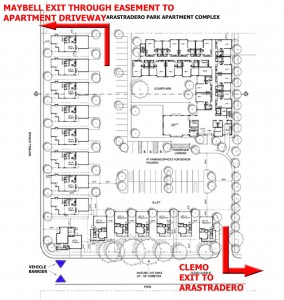The Palo Alto Housing Corporation, developer of the Maybell Homes and Senior Housing Project at the corner of Maybell and Clemo, commissioned a Traffic Study that was submitted to the City’s Planning Department in February. The traffic study was made public only recently following a request by BPA President Lynnie Melena. Click on the link to download the Maybell Clemo project Traffic Study.
The study reveals that the developer, with input from the City, has broadened the possibilities for entrance/exit by cars from what they presented at the community meetings last September. The consequence of this Traffic Study is that there is now a clear preference for traffic to/from the site to use Maybell and not Arastradero, as had been proposed initially.
The only entrance/exit proposed at the community meeting was on Clemo, and with the existing barriers at the end of Clemo near Maybell, all the traffic created by the site would then flow to/from Arastradero (The traffic study has no figures of the site itself with traffic directions so I have created them using their site plan on which I superimposed arrows: Maybell runs vertically on the left, Clemo runs horizontally at the bottom).
In a second proposal in this Traffic Study, which is the one preferred by the developer, the project would be served by two driveways—one driveway on Clemo Avenue and a second via an access easement through the adjacent Arastradero Park Apartment Complex (a property that is also owned by the Palo Alto Housing Corporation) to the north that would connect to an existing driveway on Maybell Avenue.
Each of these proposals has two scenarios. The second scenario – suggested by the City of Palo Alto, according to the Traffic Study – is to relocate the barrier on Clemo Avenue from its existing location near Maybell Avenue to immediately east of the proposed project site driveway on Clemo. As a result, this would block all traffic to/from Arastradero and all traffic generated by the project would flow to/from Maybell.
What about the Traffic – from the Conclusion of Study
The consults favor this last configuration. They conclude, from an analysis of the traffic generated by the project, that even under this last proposal with the traffic barriers moved “ residents along Maybell Avenue would not notice a change in traffic as a result of the proposed development. As stated earlier, given the severity of queuing, bike and pedestrian trips on Arastradero Road, it would be beneficial to relocate the barrier on Clemo Avenue to east of the project driveway, so that the project trips cannot access Arastradero Road via Clemo Avenue.”
You may wonder what criteria the consultants use to say that the residents along Maybell ‘would not notice a change in traffic.’ They use an assessment based on a model that starts with the average daily traffic (ADT) volume and then state that a 20 to 30% increase in traffic could be added to a roadway before residents would perceive the increase. As a baseline, they use the ADT weekday of 3320 on Maybell Ave and estimate the average increase from the project would be 120, which is well below their criteria of what is a noticeable increase. However, they do not mention that the ADT on Maybell increased by 25% over what it was prior to the Arastradero restriping project and is already at a level that exceeds ” 2500 vpd, the maximum acceptable volume on a local residential street as defined by Palo Alto’s neighborhood traffic calming program.” [Gale Likens, former Palo Alto Transportation manager in Establishing thresholds of significance under CEQA]
The study strongly favors the Clemo auto barrier relocation, which would direct all the traffic to/from the site to Maybell. “The barrier relocation may be beneficial in that it would prevent project trips from attempting to access Arastradero Road from a stop-controlled approach that is affected by significant queuing issues and bike and pedestrian trips during peak periods. While similar issues are present at the Maybell/Clemo intersection, they are less severe as the traffic volume on Maybell is much lower than on Arastradero.”
The single family homes have garages in the rear and their entrance/exit traffic would be serviced by the site’s main driveways rather than directly onto Maybell or Clemo. This was a change from the first concept, in recognition of the the fact that during the periods between 7:45 and 8:15 AM Maybell Avenue is congested and “there are hundreds of pedestrians
and bikes that use the Maybell corridor during this period to access the nearby schools. “
The study acknowledges the already serious problems that occur during AM peak hours on Arastradero: “.. this intersection [Clemo and Arastradero] is currently subject to frequent blockages as queues extend along Arastradero Road from the downstream intersection at Coulombe Drive past Clemo Avenue. Thus, the “Clemo via Arastradero” access alternative, which would funnel all of the project traffic through the Clemo/Arastradero intersection, would exacerbate the existing congestion at this intersection. In contrast, moving the Clemo barrier to the east of the project driveway so that all project trips would access Clemo Avenue via Maybell Avenue would result in less delay.”
Next Steps
The project will be reviewed by the Planning and Transportation Commission sometime in the coming months. In the meantime, if you have opinions about the study and its conclusions that you want the City staff to hear, send them to Curtis Williams, Director of the Planning and Community Environment Department (curtis.williams@cityofpaloalto.org), and to Tim Wong, the City’s staff planner assigned to the project (tim.wong@cityofpaloalto.org).
The Barron Park Association Board would also like to hear your views as well. Send an email to BPA-Board@googlegroups.com.
You can add your comments to this post if you register as a “user” on our website – click on the register link and enter a username and choose a password in the top of the left hand sidebar on our home page (this is required to prevent spammers from adding comments).


